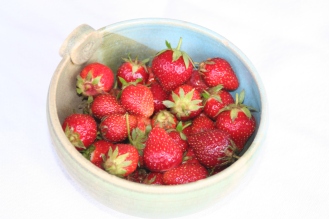Imagine life without avocados, pumpkins or chocolate. I simply cannot. The Native peoples of lands now called Mexico and Peru began a great transformation of ordinary flowering plants into food staples long before Columbus’ visit. Mesoamerican and Andean botanists bred wild Solanum family plants into tasty varieties: tomatoes, potatoes, bell peppers, and chile peppers. The name tomato in English and tomate in Spanish comes from the Nahuatl (Aztec): tomatl.
Farmers in the region now known as Southern Mexico and Central America domesticated and cultivated corn, beans, avocados, chocolate, sunflowers, squash, and pumpkins. (see here for the update on chocolate) The Northern Andean peoples’ innovations were cassava, potatoes, sweet potatoes, peanuts and quinoa. Due to these outstanding agricultural products, major civilizations with huge population centers flourished. Through trade routes among the First Nations peoples the food wealth was shared across the Americas north and south.
I am grateful to the Spanish for introducing these edibles to Europe, and the Portuguese traders for taking them to the rest of the world. Thanks to the research of Jodi Ettenberg in Legal Nomads, I learned how these novel seeds were transported far and wide (Portuguese sea trade routes!) This botanical sharing took place 500 years ago, so far past our great-grandparents that we have trouble believing that these plants were once not part of international cuisine. What is more Spanish than gazpacho? What’s more Irish than potatoes? What’s more Thai than spicy food? Over five centuries, the world adopted these culinary transplants so completely, we can scarcely believe there was a time before they were planted and harvested throughout the globe.
What did people eat before these fruits and vegetables were embraced in new continents? The food was bland to be sure. Think of the daily meals the famous French chef cooked for the two austere sisters in the Danish movie Babette’s Feast; boiled cod with no spice. Then think of the delicious dinner Tita prepares in Like Water for Chocolate, turkey mole; a sauce made with three kinds of chiles, chocolate, and a dozen more ingredients. I’m tempted to say, when Europeans met the Native People of the Americas, who civilized whom? I should retitle this essay, “How the Maya and Inca Feed the World.”
Which is your favorite food from the Americas? Which food would it be difficult to live without? Mine is avocados. Hard to decide? Let me make it a little more challenging: papaya, pineapple, strawberries and blueberries are also natives of the Americas!

Gracias for reading and making comments! Olé! -Rebecca
Para leer este ensayo en español, haz un clic en Como los maya y los incan alimentaron al mundo.

Hmm, I’d have to say that chocolate is my favorite, we’re on an avocado kick now, and we really enjoyed the beans and squash that we grew in our garden this summer 🙂
LikeLiked by 2 people
Great foods from the Americas. I’m thankful for the bountiful harvest of your garden as well! Thanks for sharing comments and tasty veggies! -Rebecca
LikeLike
My favorite would have to be chocolate followed by avocado and sweet potatoes.
LikeLiked by 2 people
Thanks, Mom! It’s difficult to pick just one. Truthfully, I was torn between avocados and chocolate as number one. You and I share our top 3.
LikeLiked by 1 person
I am new to your blog and find it so informative.
This post in particular? Avocados. I call them the food of the gods! I love them and they play a big part in my diet. Now I know to thank my southern neighbors for carrying on this ancient discovery!
LikeLiked by 2 people
Thanks, Laurie! I appreciate your comment. We are agreed on how wonderful avocados are. : )
LikeLiked by 1 person
I love it! Grand article! I eat an avocado everyday, and a square or two of extra dark chocolate. Yum! So thankful. 😉
LikeLiked by 2 people
Those sound like good days to me. : )
LikeLiked by 2 people
Pineapple! Cant live without it! Hate avocados though! But chocolate? Yum! Thanks to the Spanish for all these culinary delights!
LikeLiked by 2 people
You’re the second person I’ve met who doesn’t like avocados. The texture isn’t for everyone. So glad the Spanish got lost in the Americas so the world can enjoy these foods. : )
LikeLiked by 1 person